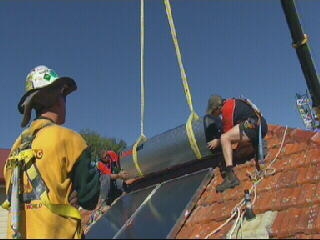The Home Front
 While politicians clash noisily over global warming and how to fight it, millions are trying modestly to cut their energy use, to be a small part of a big solution. But their efforts to save energy at home are being hampered by vested interests and a bewildering variety of rules and rebates, local, state and federal.
While politicians clash noisily over global warming and how to fight it, millions are trying modestly to cut their energy use, to be a small part of a big solution. But their efforts to save energy at home are being hampered by vested interests and a bewildering variety of rules and rebates, local, state and federal.
Households make 20 per cent of Australia's greenhouse gas emissions. Experts say household emissions could be cut by close to a third. Their prescription is a cocktail of moderate reforms that would change the way Australians build their homes, heat them, cool them and light them, and a tougher approach to power-guzzling products.
If there is a single instrument that could improve the energy efficiency of new houses, it is Australia's building code, which sets minimum required standards for the building industry.
But how stringent are those standards? Compared with other countries, not stringent at all. Typically, better design means more up-front cost - but that is offset by energy savings over time. "Not only are you reducing greenhouse gas emissions but you've got more money in your pocket," says energy policy consultant George Wilkenfeld.
If smarter home design can radically cut energy use, what can be done about the products inside? If, for example, you've installed banks of funky "low-voltage" halogen lights, did you know you're facing big power bills? Or that the giant plasma TV may be gulping more power than anything else in the house?
Large-screen TVs are among a number of new, energy-sapping products that are not yet required to have energy labelling or to meet any mandatory minimum standard. But even for appliances that wear them, can the energy star labels be trusted?
Includes footage of laboratory tests on some cheap imported appliances which carry stars boasting energy efficiency and sell by the thousands each year - with alarming results are alarming.
FULL SYNOPSIS
